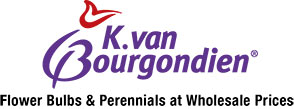-
Spring Planting
Order now for best selection.
-
Fall Planting
Available for preorder for Fall 2024 delivery.
-
Bulk Flower Bulbs
Big savings on bulk orders!
- New
-
Gardening Resources

With 175 years of experience, you can count on K. van Bourgondien to provide you with top-quality Dutch bulbs and perennials for all your landscaping and gardening needs. Sign up to receive exclusive email offers, tips and updates about our newest products from us right in your inbox.
Sign up today to receive exclusive deals and free shipping on your order of $99+.
Oops, there seems to be an error, please re-enter your email address.
We respect your privacy. You can unsubscribe anytime.

- WHOLESALE SOLUTIONS for:
- Landscapers
- Resellers
- Home Gardeners
Flower Bulbs & Perennials at Wholesale Prices
-
Spring Planting
Order now for best selection.
-
Fall Planting
Available for preorder for Fall 2024 delivery.
-
Bulk Flower Bulbs
Big savings on bulk orders!
- New
-
Gardening Resources





